Trust me, the irony of this article isn’t lost on me.
Despite making an app called One Deep Breath, here I am writing a piece about the dangers of deep breathing.
I know it’s a horrendous marketing move, but I think it’s an important one to make because the truth is, one of the biggest myths out there is that “deep” breathing is automatically better for you.
Heck, that’s why we named our app One Deep Breath – because we fell in love with the idea that when life gets stressful or overwhelming, we could all use a “deep” breath (also, in my defense, “One Slow Breath Through the Nose while Engaging the Diaphragm and Exhaling Fully” doesn’t quite have the same ring to it).
Deep breathing definitely has its place, but it shouldn’t be viewed as the cure-all to anxiety, stress, or panic attacks.
In fact, deep breathing might actually cause or worsen stress, anxiety, and panic attacks if used in the wrong situation or done incorrectly.
Our breath has the power to influence our mental and physical state, but only if used correctly.
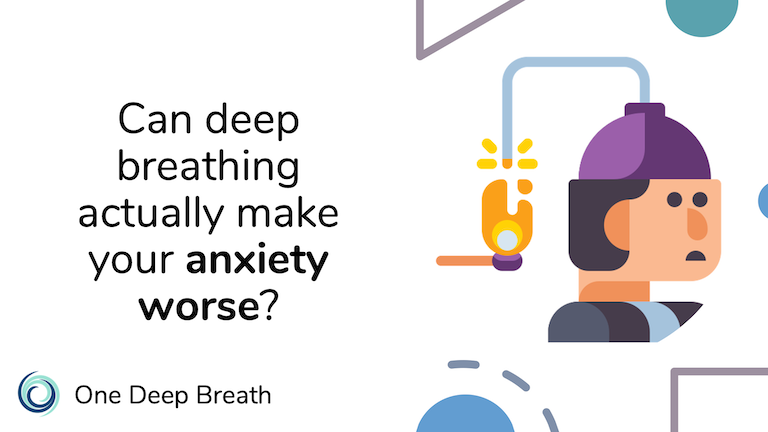
What we need to focus on is not deep breathing, per se, but better breathing.
The problem with deep breathing
Have you ever noticed what happens to your breathing when you become stressed out?
It becomes rapid, heavy, and takes place mainly in the chest.
The interesting thing is, as soon as you notice how fast you’re breathing, you instantly get the sensation that we’re not breathing enough. It can feel like you’re choking or gasping for air, and that you could really use a deep breath to calm down.
While taking a slow breath for stress or anxiety is a great idea, the notion that we need to take a deep breath and inhale a bunch of oxygen to calm down is actually the opposite of what we need.
Oxygen is what got us here in the first place – what we need is more carbon dioxide.
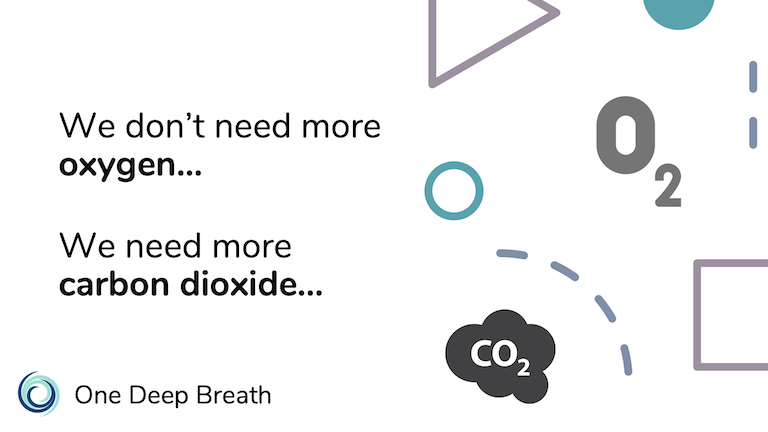
Now I’m not bringing these molecules into the discussion just to make the article more confusing. This oxygen/carbon dioxide distinction is important to elaborate on because it’s something that goes completely against what most of us are led to believe.
Most of us like to think of breathing in simple black and white terms: oxygen in, carbon dioxide out. Oxygen = fuel, carbon dioxide = waste. Oxygen good, carbon dioxide bad.
But it’s not that simple.
The oxygen myth
When we think of the little particles that make a nice, slow breath feel so good, we’re inclined to think that oxygen is doing the heavy lifting. This is partially true, but we’re actually mistaken in thinking that the oxygen we inhale is behind this effect.
Really, carbon dioxide is the reason a slow breath can help us calm down and feel better when we’re stressed out.
To understand this point, we need to differentiate between two types of oxygen in the body:
- The oxygen you inhale through the breath
- The oxygen your body can actually use/absorb from the bloodstream
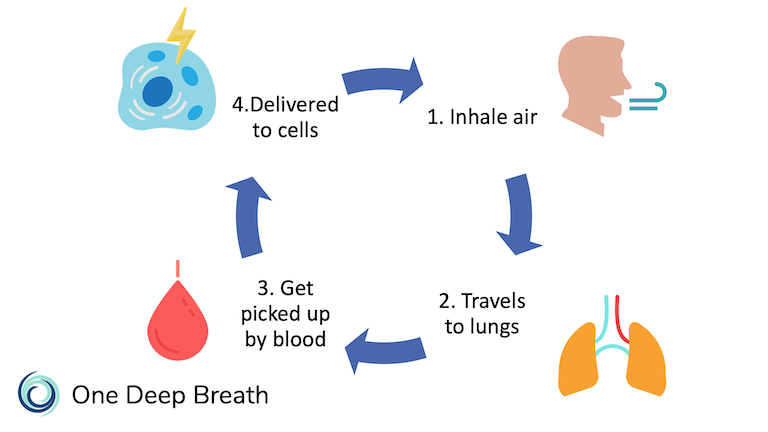
When you inhale air, it travels to the lungs and the oxygen gets transported by red blood cells around the body and delivered to cells that need it for energy.
Some cells, the active ones (eg: your hips while running or squatting), get more oxygen than others – but how does the body know which cells need more oxygen and which ones don’t?
By how acidic the blood is, or the pH level.
Cells in really acidic areas pick up tons of oxygen, while areas that are more alkaline don’t. Acid acts as a “signal” for oxygen, and a ton of other things in the body.
If you’ve ever worked out really hard and felt the effect of “lactic acid” in a particular part of your body, you can get an idea of this effect. Maybe you feel a burning sensation in the area, or near immediate soreness. This lactic acid is a signal to the body to send more resources to areas that need it.
So is carbon dioxide.
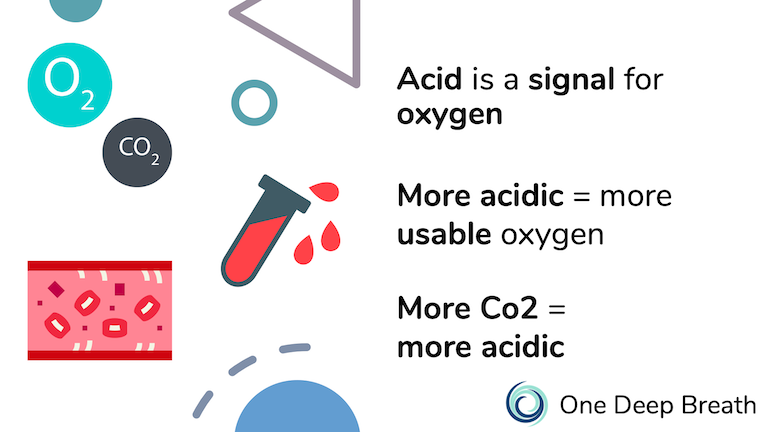
When the cells use oxygen as fuel, they release carbon dioxide into the bloodstream. Carbon dioxide is acidic, which makes the blood more acidic and acts as a signal to red blood cells to drop off fresh oxygen.
Carbon dioxide is basically saying, “Hey, over here! We could use some more oxygen!”
Without carbon dioxide in the bloodstream, even if the blood has plenty of oxygen (which it almost always does), it won’t actually let go of old oxygen and absorb new oxygen.
In short, it’s carbon dioxide that actually allows the body to absorb oxygen.
TLDR; want more usable oxygen? Increase carbon dioxide levels.
Most of us are breathing too much
You can inhale all the oxygen you want – it’s not going to make a difference in the amount of oxygen your body actually can use.
Research shows that (unless we’re working out really hard) we all inhale way more than enough oxygen. Roughly 75% of all the oxygen we inhale just gets exhaled anyways.[p][b]
What’s interesting is that it appears most of us appear to be chronic overbreathers or chronic hyperventilators – our body is starving for usable oxygen, and our response is to try and provide it with oxygen by breathing faster and deeper, which only makes the situation worse.
James Nestor estimates that 25% of individuals suffer what he calls chronic hyperventilation, while Dr. Artour Rakhimov found that over 90% in clinical studies were “overbreathers” and that most suffered from low levels of usable oxygen in the body[a][b].
It appears that many of us might actually be taking a deep breath with every breath.
The way out of this dilemma isn’t breathing more or deeper, it’s breathing smarter.
The dark side of deep breathing
Now it’s time to connect this very important concept to deep breathing.
When we breathe deeply without also exhaling fully, we increase oxygen levels in the blood, which in turn, decreases the amount of carbon dioxide in the body.
As James Nestor describes in his book, Breath, this process, “purge[s] carbon dioxide” from the body, and that, “just a few moments of heavy breathing above metabolic needs could cause reduced blood flow to muscles, tissues, and organs”.[b]
Increased levels of oxygen in the blood leads to decreased acidity, which basically “turns off” the signals that tell your blood to deliver oxygen to cells.
So while heavy/deep breathing increases the amount of oxygen you inhale, it actually decreases the amount of oxygen you can use.
Inna Khazan Ph.D sums this effect up nicely:
“Without sufficient carbon dioxide in your bloodstream, the oxygen that is circulating in your blood does not get released in sufficient quantities, and your brain, muscles, and other organs become deprived of oxygen.”
Inhaling more oxygen isn’t the answer, especially when we’re stressed out or hyperventilating, because oxygen is what got us into trouble in the first place. Research shows that in the moments leading up to a panic attack, oxygen levels rise, not fall, and they do so rapidly.[m]
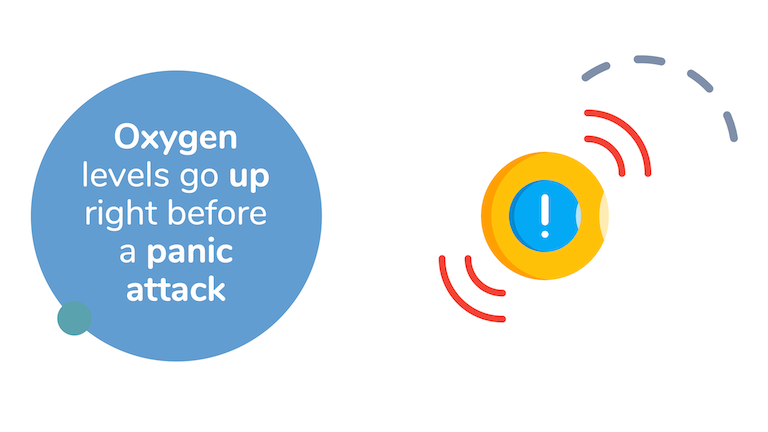
This elicits a stress response, and we feel like we’re choking, even though what we really need is less air.
Our response is the opposite of what we should do – breathe more, which only heightens the stress response and sense of panic.
Still, with a few tweaks, conscious breathing can help us get out of fight-or-flight mode and remain calm.
The science behind the perfect breath
Deep breathing can feel really good and relaxing, and there’s a solid explanation for this – when we breathe deeply, we consciously try to slow down the breath, allowing air to fill the lungs. Sometimes we even engage the diaphragm.
This process actually turns on our body’s “rest-and-relaxation” mode, the parasympathetic nervous system.
The lungs are intimately entangled with the autonomic nervous system, which is in charge of making sure all our body’s “automatic” processes are taken care of. It makes sure our heart is beating, our digestive system is running smoothly, and we have the hormones we need to thrive.
The nerves at the top of the lungs are more likely to be attached to our body’s “fight-or-flight” mode, the sympathetic nerve system, which makes us feel stressed out, overwhelmed, and rushed. When we breathe shallow, rapid, heavy breaths, we keep stimulating these nerves over and over again, triggering the release of adrenaline and cortisol.
Conversely, by slowing down and allowing air to spread around the lungs completely and engage the diaphragm, we stimulate the vagus nerve, which is a powerful gateway to the relaxing side of our nervous system.
By slowing down the breath, we can consciously choose to lean our body towards rest-and-relaxation, even in times of stress.
If we slow down the breath and add a hold or a pause to our breathing, we can also increase carbon dioxide levels, which will decrease the stress response and provide our body with the usable oxygen it craves. It’s part of the reason that deep diaphragmatic breathing has been shown to help stress, panic attacks, anxiety, and depression.[b][m]
So deep breathing isn’t not all bad, necessarily – but there are some tweaks we should make if we’re going to really optimize it for our health.
How to take the perfect breath
When we’re in a state of panic, stress, or anxiety, we want our breathing to accomplish two things:
- Increase levels of carbon dioxide so that we can have more usable oxygen
- Trigger the parasympathetic nervous system, our rest-and-relax mode
To do this, we really only need to focus on just three key aspects of breathing: slowing it down, breathing through the diaphragm, and exhaling completely.
1. Slow it down
Slowing down the breath allows carbon dioxide levels to rise so that you can eliminate feelings of panic or stress.
Focus on slowing down the inhale and exhale to a count of at least 5, or alternatively, add a pause between inhales and exhales.
Our Optimal Everyday pattern is a good way to train yourself to breathe slower.
Research shows that just a few minutes of slow breathing could get panic patients out of fight-or-flight mode and that in just a few rounds carbon dioxide levels rose considerably.[b]
Remember though, the key is not to take deep breaths, but slow breaths. You don’t necessarily have to take shallow breaths either, just do what feels natural without focusing on how much air you take in.
2. Engage the diaphragm
The diaphragm is the best pathway we have to consciously control the autonomic nervous system. If we can activate it, we can tap into our rest-and-relaxation mode and feel better.
Unfortunately, the typical adult only engages as much as 10% of their diaphragm while breathing.[b]
The good news is that we can overcome this with proper training.
The diaphragm is a muscle right below the lungs, around the stomach, that helps with the act of breathing. If we’re engaging it correctly, it should be doing most of the heavy lifting.
Thus, when we engage our diaphragm, we’re breathing with our “stomach”, not our chest.
It’s very hard to explain how to breathe out of your diaphragm other than to say that your stomach should expand on inhales and contract on exhales.
The easiest way to tell if you’re breathing correctly is by checking if your chest and shoulders rise, or puff up while you’re breathing.
If your chest or shoulders rise or expand during breathing, you are not engaging the diaphragm.
Your shoulders and chest should stay level the entire breath, while the stomach expands and contracts. It takes practice, but the research-based benefits of diaphragmatic breathing are huge:[d]
- Decreased stress response
- Decreased rates of anxiety and depression
- Prevents emotional exhaustion and job burnout
3. Exhale completely
This isn’t going to be true for everyone, but personally when I used to take deep breaths, I would take a lot of joy in the long, drawn-out exhales.
That’s because the exhale itself is a parasympathetic, or rest-and-relaxation, response.[b]
If you already take long, full exhales, that’s great, but if not, really try to lengthen the exhales, making them a second or two longer than the inhales.
Doing so helps increase carbon dioxide levels in the body and flush out all that oxygen that you inhaled.
In defense of “taking a deep breath”
The central idea behind “taking a deep breath” is a healthy one. I think we can all agree that there are times throughout the day that we should take a step back and breathe, and that maybe the world might be a little less anxious, a little less stressed out if we learned to do so.
Unfortunately, the age-old advice of taking a “deep” breath might not be the best idea, but then again, I don’t see myself telling my irritated co-worker or stressed out family member to “take a slow breath using the diaphragm with an accentuated exhale” anytime soon.
Just remember, when it feels like you should take a deep breath, opt for a better breath instead, and if you want guides and animations for better breathing, you can download the One Deep Breath app to see all our patterns for stress, anxiety, sleep, and more at OneDeepBreath.io.
Sources
[s]https://www.sciencedirect.com/topics/neuroscience/bohr-effect
[p]https://www.psychologytoday.com/us/blog/biofeedback-and-mindfulness-in-everyday-life/201912/do-not-take-deep-breath
[m] https://www.ncbi.nlm.nih.gov/pmc/articles/PMC3327298/
[a] https://www.normalbreathing.com/
[d] https://www.ncbi.nlm.nih.gov/pmc/articles/PMC5455070/




